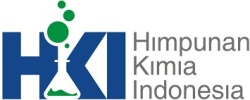Optimization of Extraction and Measurement Methods in the Determination of Total Iron (Fe) Content in Anti-Anemia Multivitamin Capsule Samples
Abstrak
Iron (Fe) is a transition metal that plays a critical role in human life, particularly as a micronutrient. The objective of this study is to optimize and ascertain the most appropriate method for measuring the total Fe content of anti-anemia multivitamin capsule samples, thereby ensuring the accuracy of the measurement results. The determination of total Fe content can be achieved through two metal extraction methods, namely wet digest and dry ashing methods, and two metal measurement methods, namely UV-Vis spectrophotometer and atomic absorption spectrophotometer (AAS). The findings revealed that the measurement of total Fe content by UV-Vis spectrophotometer through the dry ashing extraction method yielded a lower value (20.92 ± 0.29 mg/g) compared to the wet digest method (67.91 ± 0.83 mg/g). Furthermore, the Fe content determined by AAS analysis exhibited a reduced value in the dry ashing extraction method (1.42 ± 0.02 mg/g), while the wet digest extraction method yielded a substantially higher value (72.91 ± 4.12 mg/g). Statistical tests with the Duncan method revealed that the wet digest extraction method with UV-Vis spectrophotometer measurements is the most effective method for determining the total Fe content, with a significance level equivalent to the theoretical reference value (67.85 ± 0.03 mg/g).
##plugins.generic.usageStats.downloads##
Referensi
V. M. Nurchi, R. Cappai, N. Spano, and G. Sanna, “A friendly complexing agent for spectrophotometric determination of total iron,” Molecules, vol. 26, no. 11, pp. 1–11, 2021, https://doi.org/10.3390/molecules26113071.
I. O. Akinyele and O. S. Shokunbi, “Comparative analysis of dry ashing and wet digestion methods for the determination of trace and heavy metals in food samples,” Food Chem., vol. 173, pp. 682–684, 2015, https://doi.org/10.1016/j.foodchem.2014.10.097.
A. H. Uddin, R. S. Khalid, M. Alaama, A. M. Abdualkader, A. Kasmuri, and S. A. Abbas, “Comparative study of three digestion methods for elemental analysis in traditional medicine products using atomic absorption spectrometry,” J. Anal. Sci. Technol., vol. 7, no. 1, 2016, https://doi.org/10.1186/s40543-016-0085-6.
F. R. Adolfo et al., “Simultaneous determination of iron and nickel as contaminants in multimineral and multivitamin supplements by solid sampling HR-CS GF AAS,” Talanta, vol. 195, no. December 2018, pp. 745–751, 2019, https://doi.org/10.1016/j.talanta.2018.12.010.
C. J. Taylor et al., “A Brief Introduction to Chemical Reaction Optimization,” Chem. Rev., vol. 123, no. 6, pp. 3089–3126, 2023, https://doi.org/10.1021/acs.chemrev.2c00798.
A. Pequerul, C. Pérez, P. Madero, J. Val, and E. Monge, “A rapid wet digestion method for plant analysis BT - Optimization of Plant Nutrition: Refereed papers from the Eighth International Colloquium for the Optimization of Plant Nutrition, 31 August – 8 September 1992, Lisbon, Portugal,” M. A. C. Fragoso, M. L. Van Beusichem, and A. Houwers, Eds., Dordrecht: Springer Netherlands, 1993, pp. 3–6. https://doi.org/10.1007/978-94-017-2496-8_1.
L. El Hosry, N. Sok, R. Richa, L. Al Mashtoub, P. Cayot, and E. Bou-Maroun, “Sample Preparation and Analytical Techniques in the Determination of Trace Elements in Food: A Review,” 2023. https://doi.org/10.3390/foods12040895.
J. Hassan, S. M. Shermeh, M. K. Koohi, and A. Pourshaban-Shahrestani, “A green chemical analysis of iron (III) in water sample using a smart phone,” MethodsX, vol. 12, p. 102724, 2024, https://doi.org/10.1016/j.mex.2024.102724.
F. Dara and Y. Susanto, “Determination of Iron (Fe) and Calcium (Ca) in NIST SRM 1566b (Oyster tissue) using Flame Atomic Absorption Spectrometry (F-AAS) by Standard Addition Method,” J. Kim. Val., vol. 2, May 2011, https://doi.org/10.15408/jkv.v2i2.205.
J. Aleong and D. Howard, “Extensions of the Duncan’s Multiple Range Test for unbalanced data,” J. Appl. Stat., vol. 12, no. 1, pp. 83–90, Jan. 1985, https://doi.org/10.1080/02664768500000009.
I. Fabunmi, O. Omotola, U. Paul, and A. Adeleye, “Evaluation of the Effectiveness of Different Acid Digestion on Sediments,” IOSR J. Appl. Chem., vol. 7, pp. 39–47, Jan. 2014, https://doi.org/10.9790/5736-071213947.
I. Bankaji et al., “Comparison of Digestion Methods Using Atomic Absorption Spectrometry for the Determination of Metal Levels in Plants,” 2023. https://doi.org/10.3390/separations10010040.
H. Herlinawati, N. Arpi, and N. Azmi, “Comparison of Wet Destruction, Dry Ashing, and Acid Homogenic Methods In Determining Na And K in Beef and Chicken Using Flame Photometer,” Indones. J. Chem. Sci. Technol., vol. 3, p. 81, Aug. 2020, https://doi.org/10.24114/ijcst.v3i2.19533.
G. K. Harris and M. R. Marshall, “Ash Analysis BT - Food Analysis,” S. S. Nielsen, Ed., Cham: Springer International Publishing, 2017, pp. 287–297. https://doi.org/10.1007/978-3-319-45776-5_16.
S.-M. Park, S.-W. Lee, P.-Y. Jeon, and K. Baek, “Iron Anode-Mediated Activation of Persulfate,” Water, Air, Soil Pollut., vol. 227, no. 12, p. 462, 2016, https://doi.org/10.1007/s11270-016-3169-4.
A. Boonmee et al., “Design and Development of the Experimental Kit for Limiting Reagent Study Using a Smartphone,” pp. 177–188, Jan. 2020.
S. Kurniawati and D. Sugiarso, “Perbandingan Kadar Fe (II) dalam Tablet Penambah Darah secara Spektrofotometri UV-Vis yang Dipreparasi Menggunakan Metode Destruksi Basah dan Destruksi Kering,” J. Sains Dan Seni Its, vol. 5, no. 1, pp. 1–5, 2016.
Y. Siregar, N. Sinaga, and H. Hutagalung, “Pengaruh Budaya Sistematis Rekrutmen dan Penempatan Kerja Terhadap Kinerja Karyawan pada PT. Pos Indonesia Cabang Sibolga,” J. Mhs., vol. 5, no. 1, pp. 39–50, 2022, [Online]. Available: http://repo.iain-tulungagung.ac.id/5510/5/BAB 2.pdf
D. Chicco, M. J. Warrens, and G. Jurman, “The coef fi cient of determination R-squared is more informative than SMAPE , MAE , MAPE , MSE and RMSE in regression analysis evaluation,” pp. 1–24, 2021, https://doi.org/10.7717/peerj-cs.623.
E. Prihatini, R. Ismail, I. S. Rahayu, and R. Ramdhani, “Uji Performa Alat Vakum Tekan Termodifikasi Untuk Impregnasi Kayu,” J. Pengelolaan Lab. Pendidik., vol. 5, no. 2, pp. 75–82, 2023, doi: 10.14710/jplp.5.2.75-82.
H.-Y. Kim, “Statistical notes for clinical researchers: post-hoc multiple comparisons.,” Restor. Dent. Endod., vol. 40, no. 2, pp. 172–176, May 2015, https://doi.org/10.5395/rde.2015.40.2.172.
 This work is licensed under a Creative Commons Attribution-ShareAlike 4.0 International License. Copyright is retained by the authors, and articles can be freely used and distributed by others.
This work is licensed under a Creative Commons Attribution-ShareAlike 4.0 International License. Copyright is retained by the authors, and articles can be freely used and distributed by others.

 Rohmat Ismail(1*)
Rohmat Ismail(1*)












